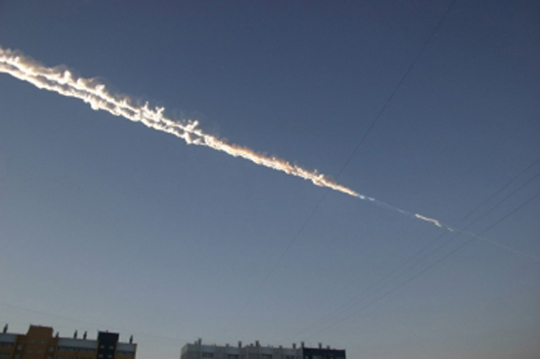


- MAKE YOUR OWN EXHIBIT
- WATCH A VIDEO
- READ A BLOG
- TACTILE & BRAILLE HTE
- AMERICAN SPACES
- PIN SOME IMAGES
- SHARE WITH A FRIEND

Sonic Boom Across Russia
February 15, 2013

Image Credit: Russian Emergency Ministry
This news from Russia this morning is rather sobering. Here's a report from the Washington Post:
A meteor broke up in the sky Friday morning over the Ural Mountain city of Chelyabinsk, and the shock wave from the explosion smashed windows, collapsed roofs and injured more than 900 people.
The story goes on to outline how witnesses seeing the streaking object across the sky heard no sound until the sonic boom blasted through the area.
This is an example of how objects from space can influence and impact our lives here on Earth. It is also an example of how bow shocks behave. This meteor was clearly traveling faster than the speed of sound when it entered the Earth's atmosphere and a bow shock was created. You can learn more about how this works by replacing "airplane" with "meteor" in our HTE description of a supersonic jet:
As an airplane moves through the air, it pushes on the air in front of it, creating sound waves. If the airplane is moving faster than the speed of sound, a bow shock is created. When this shock wave passes by our position on the ground, all of the sound waves that would have normally moved ahead of the plane are combined together so at first we hear nothing, and then we hear the boom created by the accumulated sound waves.

More at http://hte.si.edu/bowshocksmore.html
There is more information on meteors traveling at highly supersonic speeds and how when large ones enter the atmosphere, they can create audible sonic booms at this website: http://www.amsmeteors.org
-Megan Watzke, Chandra/HTE

"Here, There, & Everywhere" (HTE) is supported by the National Aeronautics and Space Administration under grant NNX11AH28G issued through the Science Mission Directorate.
HTE was developed by the Chandra X-ray Center, at the Smithsonian Astrophysical Observatory, in Cambridge, MA.
Email: cxcpub@cfa.harvard.edu | Phone: 617.496.7941
Follow us: #HTEScience on Twitter